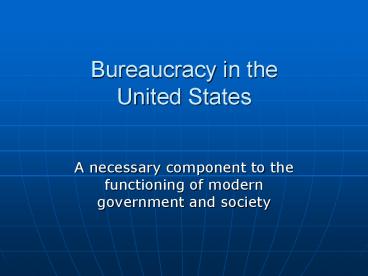Bureaucracy in the United States - PowerPoint PPT Presentation
1 / 15
Title:
Bureaucracy in the United States
Description:
... institutions (courts and political parties) and the proponents of modernization ... independent third party. The hollow center; A prologue to democratic ... – PowerPoint PPT presentation
Number of Views:42
Avg rating:3.0/5.0
Title: Bureaucracy in the United States
1
Bureaucracy in the United States
- A necessary component to the functioning of
modern government and society
2
Lecture Outline (6 main items)
- What is bureaucracy and what does it do?
- Goals of the federal bureaucracy
- Who controls bureaucracy
- Characteristics of bureaucracy
- Why is American bureaucracy different by design?
Both Skowronek and Heclo contend that our
bureaucracy is weak because of its incoherent and
piecemeal structure - What are the positive and negative consequences
of a weak bureaucracy?
3
What is bureaucracy and what does it do?
- Bureaucracy is a universal form of organization
that improves efficiency in large organizations
both public and private - In the public sector, bureaucracy is an
organizational system of public administration
(i.e., departments, agencies, bureaus,
commissions and other units of the executive
branch) through which governmental policies are
implemented - Cabinet departments secretaries from 15
dept.-cabinet - Non-cabinet/independent agencies
- Government corporations
- Regulatory agencies and independent regulatory
commissions
4
Goals of the Federal Bureaucracy
- Promote the public welfare
- More than public welfare for the poor
- Promote national security
- Control of the sources of federal government
revenue - Control of the conduct defined as threat to
internal national security - Defending American security from external
threats - Maintain strong economy
- While the government does not directly run the
economy, many federal government activities are
critical to maintaining a strong economy (i.e.,
fiscal and monetary policies)
5
Who controls bureaucracy?
- Methods of Congressional Control
- Mandatory reports
- Public hearings and Investigations
- Committee and conference reports
- Office of Inspector General
- Communications between congressional and agency
staffs - The research efforts of three large agencies
- General Accounting Office (GAO)
- Congressional Research Service (CRS)
- Congressional Budget Office (CBO)
6
Methods of Presidential Control
- Presidents from FDR to George W. Bush have
initiated ways to enhance the managerial
presidency - For example, Bushs privatization plan a process
known as federal contracting.
7
Characteristics of Bureaucracy
- Division of labor
- Fixed and legally specified functions,
responsibilities and supervision roles
hierarchical accountability - Employment by merit rather than by patronage job
tenure - Pendleton Act (1883)
8
American bureaucracy different by design
- Both Skowronek and Heclo provide reasons for our
weak bureaucracy relative to other western
democratic bureaucracies
9
Skowronek
- Skowronek analyzes the irregular foundation of
the bureaucracy in the United States as opposed
to the bureaucratic structures in Western Europe.
10
How was the bureaucratic foundation irregular?
- In the United States, 19th century political
challenges of industrialization were addressed
within a fragmented and localized political
system comprised of courts and political parties - Courts (through rule making) and political
parties (through patronage) dominated the state
realm and proved remarkably resistant to the
structural changes necessitated by modernization.
- The entrenched positions of these institutions
frustrated the efforts of the state-building
vanguard striving to implement administrative
reforms.
11
Forces of change
- By 1920, new centers of rule making had appeared
in areas such as civil service, military
administration and economic regulatory activity
though these new centers remained un-integrated
within a broader state realm. - Conflicts between the existing institutions
(courts and political parties) and the proponents
of modernization (state building vanguard) were
only partially resolved yielding an improperly
structured, weak bureaucracy rather than a
strong, well structured bureaucracy offering
corporatist planning.
12
Heclo
- A major characteristic of the American
bureaucratic system is that it is not a system at
all. In contrast to other western bureaucracies,
the US has not yet discovered the means of
meshing its higher civil service with
presidential leadership and developing a longer,
broader, professionalized government-wide
perspective.
13
Poorly defined governmental features
- Three features are all poorly defined in American
national government and are subject to immense
counter pressures. They are defined not by
hierarchies with formal, clear career lines but
by loose groupings of people where the lines of
policy, politics and administration merge. - the status of top bureaucrats,
- their role in policy making and politics,
- their relationship to the larger society
14
Key Points
- Historical anomaly
- The dual structure
- Policy and politics in the dual structure
- mix of permanent careerists
- transient appointees
- independent third party
- The hollow center
- A prologue to democratic technology
15
What are the positive and negative consequences
of a weak bureaucracy?
- What are the advantages and disadvantages of
trying to run the government more like a
business? - Should efficiency be the only priority in the
public enterprise?































